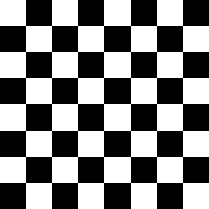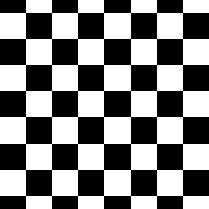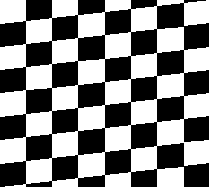Klein Bottle Checker Board Paradox
in reading Jeff Week's book Shape of Space Buy at amazon, i conceived this paradox. The question is, is it possible to color a Klein bottle with a 8 x 8 checkered pattern like a chess board, where no neighboring squares share the same color?
If we look at the chess board, then imagine the top and bottom edges are connected. That is, if a lower left point goes off towards the bottom of the edge, then it reappears on the top left of the edge. Then, we also image the right and left edges are connected. This way, what we have is a homogeneous representation of a torus. It is topologically equivalent to a torus. But if the left and right edges are connected in a way that is flipped, then we have a homogeneous representation of the space called “Klein bottle”. By “flipped”, we mean that if a point on the upper right moves off towards the right edge, then it reappears on the lower left edge (as opposed to upper left). A Klein bottle is a particular shape of a 2-dimensional space. It differ from torus in a “strange” way in that it has the property of being what's called “non-orientable”. More specifically: a shape on the surface can become its mirror image (by simplifying moving in one direction).

(Mathematica code for above: shape_space/xekri_blabi.nb)
Now back to the checker board paradox. So if we have a chess board, and imagine its top and bottom edges are connected, and right and left edges are also connected, we have a torus. Now,notice that the white colored squares on the top are connected to black colored squares at the bottom. Likewise left and right. So, throughout the torus, we have alternating colored squares. But now suppose that the left and right edges are connected with a flip representing the “Klein bottle” space. We notice that it no longer has alternating colors everywhere. The white squares on the right side are connected to white squares on the left side, similarly for black squares. Since a Klein bottle space is a closed finite space that we can shift or rotate our checkered pattern anyway we want like a oil slick, this seems to prove that it is impossible to color a Klein bottle with 8 x 8 checkered pattern, due to some inherent parity issue.
Not so! Jeff's book happens to have a picture of Klein bottle with checkered pattern. See answer below.
↓ ↓ ↓ ↓ ↓ ↓ ↓ ↓ ↓ ↓ ↓ ↓ ↓ ↓ ↓ ↓ ↓ ↓ ↓ ↓ ↓ ↓ ↓ ↓ ↓ ↓ ↓ ↓ ↓ ↓ ↓ ↓ ↓ ↓ ↓ ↓ ↓ ↓ ↓ ↓ ↓ ↓ ↓ ↓ ↓ ↓ ↓ ↓ ↓ ↓ ↓ ↓ ↓ ↓
In Jeff's book he showed the following image as the checkered pattern for the Klein bottle space:

If you connect the right and left edges with a flip, indeed the whole Klein Bottle space is patterned by alternating colored squares. Note that it is still a 8 by 8 grid. This seems to present a paradox from my previous “proof”. How does one resolve this paradox? Or, what is the logical flaw in my previous reasoning?
It turned out, that i wrongly assumed that the laying out of a grid is unique for a closed surface like torus or Klein Bottle. This is not true. On a torus for example, “the grid layout can have a twist”, like that of torus knots. With such a twist, grids will have different topology (just as different number of twists forms different torus knots).
